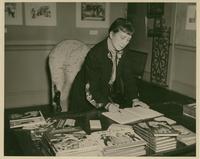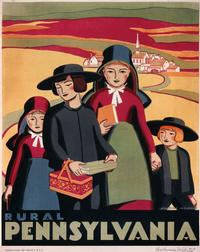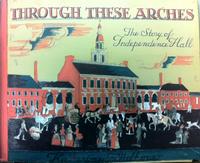Katherine Milhous (1894-1977) and Frances Lichten (1889-1961) were life partners and artistic collaborators who shared several passions: creating vibrant artwork for children and adults, entertaining in their homey studio on Pine Street, and corresponding with treasured longtime friends. They also shared a love of Philadelphia and respect for the history and cultural traditions of the region.
The Katherine Milhous and Frances Lichten papers, an impressive 40 linear feet of personal and professional correspondence, fan mail, published and unpublished artwork, research notes, photographs, journals, and scrapbooks, is now available at the Free Library of Philadelphia’s Children’s Literature Research Collection (CLRC). In 1967, Milhous donated the majority of her manuscripts, illustrations, and papers as well as several boxes of Lichten’s papers to the library, and researchers will benefit from the artist’s handwritten comments, labeled research files, and extensive notes on her own work.
Katherine Milhous was born in Philadelphia and grew up in Pitman, New Jersey. The activities, culture, and opportunities of her birthplace beckoned, and she returned to the city to study at the Philadelphia Museum School of Industrial Art and the Pennsylvania Academy of Fine Arts, where she met Frances Lichten, an artist specializing in Pennsylvania folk art. Influenced by Pennsylvania Dutch designs and crafts, Milhous is primarily known for writing and illustrating children’s books such as The Egg Tree, for which she won the Caldecott medal in 1951, and Through These Arches: The Story of Independence Hall (1964), a thorough and reverent history of the Native American settlers through the building’s restoration to its original design in 1950. The positive impact she had on audiences of all ages is reflected by the folders of fan mail, including photos of her young readers decorating their own egg trees, notes from appreciative librarians, a letter from Pat Nixon praising Through These Arches, and a letter from Philadelphia mayor Bernard Samuel referencing Patrick and the Golden Slippers (1951), her book about the Mummer’s Parade.
Researchers can explore the relationship of author and publisher through the professional and personal letters written to Milhous by Alice Dalgliesh, children’s book editor at Charles Scribner’s Sons in New York City. Dalgliesh, also an author, saw Milhous’s Works Progress Administration posters featuring rural life; she promptly invited Milhous to create the illustrations for her children’s books and then encouraged her to write her own, sparking a twenty-seven-year friendship. Lichten and Milhous worked together on the artwork for Dalgliesh’s They Live in South America (1942).
Milhous kept many files of clippings, notes, poems, and greeting cards from which she drew inspiration for her work. In addition, those interested in physical representations of the mid-twentieth century publishing process can examine outlines, galleys, preliminary and final artwork, as well as a complete dummy for Through These Arches, which Milhous considered her most important book.
Like Katherine Milhous, Frances Lichten left a tremendous impact on her chosen field. She was born in Bellafonte, Pennsylvania (near State College), and studied art in Philadelphia. She worked as a commercial artist, served as the State Supervisor for the Index of American Design, a WPA initiative, and was the Research Associate in the Decorative Arts department at the Philadelphia Museum of Art, home of the Frances Lichten Research Collection. She wrote several books on decorative and folk art as well as two featuring her own illustrations. The collection features smaller publications in which Lichten published scholarly articles, artwork including bookplates and drawings from her childhood, and several research and subject files pertaining to her research interests.
Sadly, Lichten suffered from amyotrophic lateral sclerosis, or ALS (Lou Gehrig’s disease), which eventually took her life. The debilitating disease robbed her of muscle movement, a particularly cruel fate for an artist. The collection holds several folders of correspondence documenting her condition, condolence letters from friends and family to Milhous upon Lichten’s death in 1961, and her personal effects collected by Milhous from the nursing home where her beloved Frances, her partner of 40 years, spent her final months.
For additional biographical information as well as a complete inventory of the collection, please see the finding aid for the Katherine Milhous and Frances Lichten Papers.
For more on all of the CLRC collections visit our Facebook page or follow us on Twitter for more updates from the Children’s Literature Research Collection.
- Jennifer Schnabel
Have a question for Free Library staff? Please submit it to our Ask a Librarian page and receive a response within two business days.



